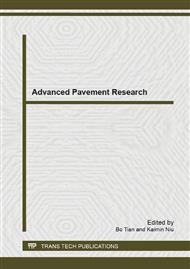p.204
p.212
p.222
p.227
p.232
p.239
p.248
p.259
p.266
Analysis on Mechanical Reasons for Longitudinal Cracking of Cement Concrete Pavement
Abstract:
This paper, in terms of structure design, mainly considers the unfavorable load position of cement concrete pavements and the finite element software is used to establish three-dimensional solid model for analysis and calculation of load stress. The results show that fatigue stress along the transverse direction is much larger than that along the longitudinal direction, and slabs are most likely to have cracking along the longitudinal direction under the combined effect of load and temperature. It is of certain significance for the prevention of longitudinal cracking of concrete pavements and the extension of pavement life.
Info:
Periodical:
Pages:
232-238
Citation:
Online since:
December 2013
Authors:
Price:
Сopyright:
© 2014 Trans Tech Publications Ltd. All Rights Reserved
Share:
Citation:


